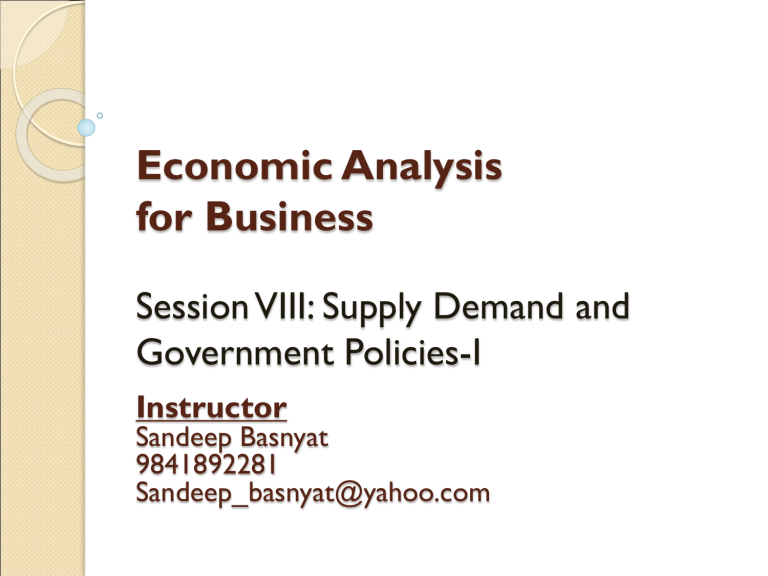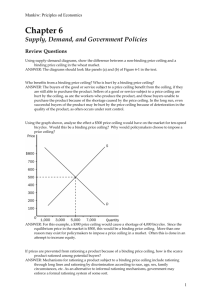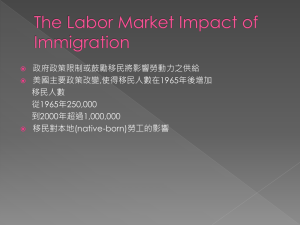Session8-SupplyDemandandGovernmentPolicies

Economic Analysis for Business
Session VIII: Supply Demand and
Government Policies-I
Instructor
Sandeep Basnyat
9841892281
Sandeep_basnyat@yahoo.com
Government Policies That Alter the Private Market
Outcome
Price controls
◦ Price ceiling : a legal maximum on the price of a good or service. Example: rent control.
◦ Price floor (Price support) : a legal minimum on the price of a good or service. Example: minimum wage.
Taxes and Subsidies
◦ The govt. can make buyers or sellers pay a specific amount on each unit bought/sold.
CHAPTER 6 SUPPLY,
DEMAND, AND
GOVERNMENT POLICIES
Price Control Policy : Rent Control in the Short
Run and Long Run
Rent controls are ceilings placed on the rents that landlords may charge their tenants.
The goal of rent control policy is to help the poor by making housing more affordable.
One economist called rent control “the best way to destroy a city, other than bombing.”
RENT CONTROL: The Market for Apartments
Eq’m w/o price controls
Rental price of apts
$800
P
S
CHAPTER 6 SUPPLY,
DEMAND, AND
GOVERNMENT POLICIES
300
D
Q
Quantity of apartments
How Price Ceilings Affect Market Outcomes
A price ceiling above the eq’m price is not binding – it has no effect on the market outcome.
$1000
$800
P
S
Price ceiling
D
Q
300
CHAPTER 6 SUPPLY,
DEMAND, AND
GOVERNMENT POLICIES
How Price Ceilings Affect Market Outcomes
The eq’m price
($800) is above the ceiling and therefore illegal.
The ceiling is a binding constraint on the price, and causes a shortage.
$800
$500
P
S shortage
250 400
D
Price ceiling
Q
CHAPTER 6 SUPPLY,
DEMAND, AND
GOVERNMENT POLICIES
How Price Ceilings Affect Market Outcomes
In the long run, supply and demand are more price-elastic.
So, the shortage is larger.
$800
$500
P
S
150 shortage
450
Price ceiling
D
Q
CHAPTER 6 SUPPLY,
DEMAND, AND
GOVERNMENT POLICIES
CASE STUDY: Lines at the Gas Pump
In 1973, OPEC raised the price of crude oil in world markets. Crude oil is the major input in gasoline, so the higher oil prices reduced the supply of gasoline.
What was responsible for the long gas lines?
• Economists blame government regulations that limited the price oil companies could charge for gasoline.
The Market for Gasoline with a Price Ceiling
Price of
Gasoline
(a) The Price Ceiling on Gasoline Is Not Binding
Supply, S
1
1. Initially, the price ceiling is not binding . . .
P
1
Price ceiling
0 Q
1
Demand
Quantity of
Gasoline
The Market for Gasoline with a Price Ceiling
Price of
Gasoline
(b) The Price Ceiling on Gasoline Is Binding
S
2
2. . . . but when supply falls . . .
S
1
P
2
4. . . . resulting in a shortage.
P
1
0 Q
S
Q
D
Q
1
Price ceiling
3. . . . the price ceiling becomes binding . . .
Demand
Quantity of
Gasoline
PRICE FLOOR (PRICE SUPPORT) : The Market for
Unskilled Labor
W
S Wage paid to unskilled workers
$4
Eq’m w/o price controls
CHAPTER 6 SUPPLY,
DEMAND, AND
GOVERNMENT POLICIES
D
500
Quantity of unskilled workers
L
How Price Floors Affect Market Outcomes?
A price floor below the eq’m price is not binding – it has no effect on the market outcome.
$4
$3
W
S
Price floor
D
L
500
CHAPTER 6 SUPPLY,
DEMAND, AND
GOVERNMENT POLICIES
How Price Floors Affect Market Outcomes
The eq’m wage ($4) is below the floor and therefore illegal.
$5
W
The floor is a binding constraint on the wage,
$4 and causes a surplus
(i.e., unemployment). labor surplus
S
400 550
D
Price floor
L
CHAPTER 6 SUPPLY,
DEMAND, AND
GOVERNMENT POLICIES
Case Study: The Minimum Wage
An important example of a price floor is the minimum wage. Minimum wage laws dictate the lowest price possible for labor that any employer may pay.
The Minimum Wage
Min wage laws do not affect highly skilled workers.
They do affect teen workers.
Studies:
A 10% increase in the min wage raises teen unemployment by 1-3%.
$5
$4
W unemployment
S
400 550
CHAPTER 6 SUPPLY,
DEMAND, AND
GOVERNMENT POLICIES
D
Min. wage
L
Impact of Minimum Wage Laws
• Skills and Experience: No effects or not binding because their equilibrium wage rates are well above minimum wage
• Teenage labour: Least skilled and least experienced. Minimum wage law hits them hard.
• Impact on quantity of labour supplied:
Increases the quantity of labor supplied as more teenagers will be interested to work, a result of which they will drop out of schools.
Evaluating the Effects of Price Controls
Prices are the signals that guide the allocation of society’s resources. This allocation is altered when policymakers restrict prices.
Price controls are often intended to help the poor, but they often hurt more than help them:
•
The min. wage can cause job losses.
•
Rent control can reduce the quantity and quality of affordable housing.
CHAPTER 6 SUPPLY,
DEMAND, AND
GOVERNMENT POLICIES
Numerical Problems
Consider a market with Demand curve q = 16 − 10p and Supply curve q = −8 + 20p .
(Here q is in millions of kgs and p is in dollars/kg)
(a)
(b)
Determine the market equilibrium price and quantity and the total revenue in this market.
Calculate the price elasticity of demand and the price elasticity of supply at the market equilibrium.
Solved Problems
Consider a market with Demand curve q = 16 − 10p and Supply curve q = −8 + 20p
.
(Here q is in millions of kgs and p is in dollars per kg.)
(a) Determine the market equilibrium price and quantity and the total revenue in this market.
Simultaneously solving the demand and supply equations: p = $0.80 per kg. and q = 8 million kgs.
Total revenue is: p x q = 0.8 x 8 = $6.4 millions.
(b) Calculate the price elasticity of demand and the price elasticity of supply at the market equilibrium.
The slope of the demand curve is −10, so the price elasticity of demand at the market equilibrium is −10.(0.8/8) = −1.
Similarly, the slope of the supply curve is 20, so the price elasticity of supply at the market equilibrium is 20.(0.8/8)= 2.
Numerical Problems
Consider a market with Demand curve q = 16 − 10p and Supply curve q = −8 + 20p .
(Here q is in millions of kgs and p is in dollars/kg) c) d)
Suppose the government sets support price of $1 per kg in this market and purchases the surplus at support price. Find the quantity demanded, quantity supplied and government expenditure in this market to implement the policy.
Illustrate in diagram the results obtained in part (c).
Numerical Problems
Consider a market with Demand curve q = 16 − 10p and Supply curve q = −8 + 20p .
(Here q is in millions of kgs and p is in dollars/kg) c) Suppose the government sets support price of $1 per kg in this market and purchases the surplus at support price. Find the quantity demanded, quantity supplied and government expenditure in this market to implement the policy.
At, support price of $1/kg,
Quantity demanded = 16 – 10(1) = 6 million kgs.
Quantity Supplied = - 8 + 20(1) = 12 million kgs.
There will be a surplus of 6 million kgs in the market.
Total Government expenditure = 6 x 1 = $6 million.
(d) Illustration of part c on Price Support Policy
$1
W
Surplus = 6 million kgs.
S
Price support
(floor)
$0.8
Govt.
Spend ing
6 8 12
CHAPTER 6 SUPPLY,
DEMAND, AND
GOVERNMENT POLICIES
D
L









